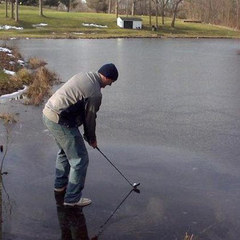-
Posts
115 -
Joined
-
Last visited
About graham57

- Birthday 01/09/1957
Personal Information
-
Your Location
Germany
Your Golf Game
- Index: 26.4
- Plays: Righty
Recent Profile Visitors
2,880 profile views
graham57's Achievements
-
We play a lot of our golf in Thailand and some of the clubs there have a „gimme circle“ with a radius of around 18“ marked on the greens. This is partly to speed up play, but the (mandatory) caddies there also have the idea that a better score enhances their player‘s pleasure, even if it has not been fully earned. For example, in addition to the one or two clublengths for normal drops, they have the „one clubhouse“ rule, which basically means throwing the ball to get their player back on the fairway! They look at me in bewilderment when I insist on dropping my own ball in accordance with the rules.
-
That tends to be my problem as well: my bad shots are typically topped balls, and I seem to get into a series of 2-3 shots when that happens. Slowing down and swinging more consciously is usually the remedy. Having said that: that one TV-worthy shot you hit during every round sticks with me longer than the bad ones!
-
I want to mention a course which is much more downmarket, but which we enjoyed so much we played it twice during our last holiday in Kissimmee: Oaks National. It has some really memorable holes, including a dog-leg where you hit your tee shot over water, then play almost at a right angle to the green, again over water. The best is a hole where the men‘s tee requires a drive over around 170 yards over high swamp vegetation to a fairway you can‘t see from the tee. I believe the green fee was around $30, and we really enjoyed the rounds we played there. To top it all: on the 10th hole a bald eagle sat on the ground and watched us play!
-
I‘d like to come back to the idea that a putting strategy can mean paying attention to where to leave the ball if you miss (e.g. below the hole giving you a straight uphill putt). This really starts with the approach shot - if I am chipping from around the green, I will try to leave myself an uphill putt, i.e. the putting strategy starts before you even get to the green.
-
I have exactly the same experience: I am a high handicapper, but play my best golf with muscle-back irons (previously Titleist 699 MB, now Mizuno MP18). I feel so comfortable with them and truly believe they help me play better. The feeling I get when I (occasionally) hit a 6-iron 190 yards and land it on the green is what I play golf for (forget those other shots, they don‘t really count!).
-
Well argued.
-
I beg to disagree. A big part of captaining is getting to know your players and working out which pairings will generate positive energy. If you listened to the interviews with the European players afterwards, the common opinion was that Thomas Björns role was „incredible“. Look at the huddles at the end of every round, the fact that his captain‘s picks scored the highest number of points ever (9.5 points), the relationship which evolved between Tommy Fleetwood and Francesco Molinari and the tears shed on more than one occasion by Paul Casey to appreciate the role Björn played as captain. Guys like Tommy Fleetwood and Tyrell Hatton are not yet fully mature as professional golfers and need guidance. They got it.
-
Rather than having to deal with gamesmanship or overly talkative types, I have had to learn to keep myself in check when playing competitive golf. I have a tendency to try to cheer my opponent or flight partner up after a bad shot, but eventually became sensitive to whether this was being received positively or whether it was better just to keep quiet. Now, I tend to limit any comments or chatter to a minimum or to times when we have to wait for the group in front to move on.
-

Has this ever happened to you? What should I do?
graham57 replied to GolfMakesMeCry's topic in Golf Talk
Golf is the greatest and most fulfilling disaster of my life. In need to get that framed!- 36 replies
-
- golf swing
- disappearing swing
-
(and 1 more)
Tagged with:
-
I live in Germany so things might be a little different here. We also have 4 courses within a 20 minute drive. In the end, we opted for the closest, simply because we reckoned on a summer evening we were more likely to play a few holes if we only had to drive 10 minutes. Another factor was the fact that our course has no tee times - you just turn up and play, and it is rare to have to wait more than a few minutes before teeing off. Also: the course is a difficult one, which means we usually find other courses easier to play. For us, being members of a club was important, as taking part in competitions and other club events adds to the social enjoyment. The only real drawback was that the club we chise was probably the „snootiest“ of the four. We reckoned we would find some normal, down-to-earth people to play and hang out with. It took a while - but worked out fine in the end! Someone mentioned clubs cooperating with each other. This has become a major factor here as clubs compete for new members. We can now play on four courses without having to oay a green fee, which is a huge plus.
-
You are probably right: „a couple“ was probably used too loosely, though the round which took her to that low handicap was in fact a 44 point round in the regional finall of a nationwide competition series, and that round won her a free trip to play Teeth of the Dog (where - despite the new low handicap - she made 40 points in the compeition final). It was that wound which took her down so far. Omge again, however: my main point is the role competitions play in club life and the possible effects of the new habdicap system, rather than the math.
-
I prefer contacts to the distraction of worrying that in summer my glasses will slip off my sweating face when I am putting (has actually happened). Now I just can‘t see the green layouts, etc. on my GPS watch!
-
Several posts point out that there are different factors that make a course tough. I have played a couple of courses immediately following a pro tour competition, and the greens were murderously fast, making it almost impossible for me to get an approach shot to stop on the putting surface. I have played a couple of really tough layouts, including Pete Dye‘s Teeth of the Dog and Dye Fore (which I preferred) in the Dominican Republic and a fantastic course in Spain, and find that my game rises with (but not necessarily to) the challenge. On the Spanish course (La Galiana near Valencia, for those who get the chance), I spoke to some guys from an English ex-pat golf society, who told me most of their members refuse to play there, because it is too tough. For me, it was one of the best golfing experiences of my life. My wife on the other hand, who has a lower handicap than me, hated it, saying it was too tough to be fun. A course near us has 9 hilly holes with sloping fairways, big elevation differences, blind shots, etc., and 9 flat holes alongside a river. The overall slope rating is 136, mainly due to the first 9 holes. I invariably play pretty well on the hard holes and dismally on the easy ones!
-
graham57 started following World Handicap System Now Out (2020)
-
Everything you write is correct (except that the „ceiling“ for your handicap being raised has now been reduced to 26.5) - I am just not sure where it contradicts what I wrote. According to an article on handicaps on the website of the German Golf Association, any score over 30 Stableford points represents a „good“ round, based on the logic that your handicap represents your best, rather than your average performance. As the table shows, the reward for a good score (i.e. >36 points) is greater than the penalty for a bad one, so your handicap tends to go down faster than it goes up. My wife had a really good season a while ago, going from a 34 handicap to 26.1 in only a couple of competitions. At the end of the season, the club‘s handicap committee decided to „reward“ her by assigning her a handicap of 24.1. In the following 8 competitions she played in, she failed to reach the buffer zone and went up to 24.9. This continual „failure“ to play to her handicap reduced the enjoyment for her, and it is only recently that she is playing consistently to her handicap and has a genuine chance of reducing it further. The point I was making is that compeitions are one of the main things that get a large number of members together who normally might not even know each other, and that de-linking handicaps from competitions might potentially „individualise“ club life more than today, which I would find regrettable.




